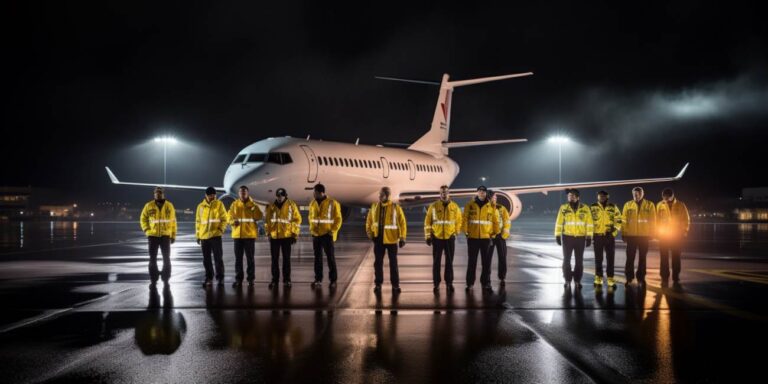During aircraft marshalling, ground crew members, known as marshals, communicate with the flight deck using a standardized set of hand signals. These signals cover a range of instructions, from directing the aircraft to stop or proceed to indicating turns and adjusting speed. It serves as a non-verbal means of communication, particularly in situations where engine noise or other factors may hinder verbal exchanges.
The primary objective of aircraft marshalling is to enhance safety by preventing collisions, ensuring proper spacing between aircraft, and guiding them along designated paths. This process is crucial not only on busy airport aprons but also in more confined spaces like aircraft carrier decks where precise maneuvering is paramount.
Key signals in aircraft marshalling include the well-known “Follow Me” sign, where a ground vehicle leads the aircraft to its designated location. Additionally, the “Stop” and “Hold” signals are vital for halting an aircraft’s movement during critical phases. Marshals also use bright wands, batons, or lighted devices during low-visibility conditions to ensure effective communication.
The significance of aircraft marshalling extends beyond routine ground operations; it is especially crucial during emergencies or when an aircraft requires immediate attention. In such cases, marshals play a key role in guiding emergency vehicles and assisting in the rapid evacuation of passengers if needed.
Training for aircraft marshalling is meticulous, involving both theoretical knowledge and practical exercises. Marshals must be well-versed in aviation regulations, aircraft types, and, of course, the standardized hand signals. Their proficiency directly contributes to the efficiency and safety of ground movements in the airport environment.
Marshalling signals and communication for safe aircraft guidance
In the intricate dance of aviation, where safety is paramount, the marshalling signals play a pivotal role in guiding aircraft on the ground. These signals, often orchestrated by ground crew members, serve as a silent language ensuring the smooth and secure movement of planes across airport tarmacs. The essence lies not only in communication but in the precision of signal marshalling.
The communication protocol for marshalling signals is standardized globally, ensuring that pilots and ground crews, irrespective of their origin, comprehend the commands with precision. This standardized system minimizes the risk of misinterpretation, a critical factor in the busy and bustling environment of an airport. The International Civil Aviation Organization (ICAO) defines and regulates these signals to create a seamless, universal language for aircraft guidance.
Marshalling signals primarily involve a series of visual cues and gestures that are universally recognized. These cues range from the classic “Follow Me” signal—a ground crew member guiding an aircraft with illuminated wands—to more intricate signals denoting specific actions such as stopping, turning, or adjusting speed. The clarity of these signals is paramount, considering the size and complexity of modern aircraft.
One of the critical aspects of marshalling signals is the training of ground crew members. These individuals undergo rigorous training programs to ensure not only their safety but also the safety of the aircraft and everyone on board. The importance of clear and concise communication cannot be overstated, and the competency of ground crew members is a linchpin in this regard.
Advancements in technology have introduced additional layers to the realm of aircraft guidance. Wireless communication systems enable real-time interaction between ground crews and pilots, enhancing the efficiency of the marshalling process. This integration of technology not only expedites the communication but also provides an avenue for immediate clarification in case of ambiguity.
A comprehensive understanding of airport layout is indispensable for effective marshalling. Ground crew members need to be well-versed with taxiways, runways, and parking areas. This knowledge ensures that the aircraft is guided along the most efficient route, minimizing taxi time and contributing to overall airport efficiency.
Moreover, the collaboration between air traffic control (ATC) and ground crews is vital. The seamless transition from air to ground guidance requires a synchronized effort, where information flows seamlessly, and decisions are made collectively. This coordination is particularly crucial during peak hours when airports experience a surge in aircraft movements.
As airports continue to evolve and accommodate larger fleets, the role of marshalling signals becomes increasingly significant. The integration of automated systems and artificial intelligence is on the horizon, promising further precision and efficiency in aircraft guidance. However, the human touch, with its innate ability to adapt to unforeseen circumstances, remains an irreplaceable element in ensuring safe aircraft movements on the ground.
| Key Points | Summary |
|---|---|
| The importance of standardized marshalling signals | Global communication protocol for aircraft guidance |
| Visual cues and gestures in marshalling | Universal signals for actions like stopping, turning, and speed adjustment |
| Training of ground crew members | Rigorous programs to ensure competency and safety |
| Role of technology in marshalling | Wireless communication systems for real-time interaction |
| Understanding airport layout | Knowledge of taxiways, runways, and parking areas for efficient guidance |
| Collaboration between ATC and ground crews | Coordination for seamless transition during peak hours |
| Future trends in aircraft guidance | Integration of automated systems and AI for enhanced precision |
Equipment needed for proper and efficient aircraft marshalling
When it comes to ensuring the safe and efficient movement of aircraft on the ground, having the right equipment for proper aircraft marshalling is paramount. This task requires a combination of precision, communication, and safety measures. Let’s delve into the essential gear that plays a pivotal role in this process.
First and foremost, yellow vests are a staple for aircraft marshalling crews. These high-visibility garments not only make the marshalling team easily identifiable amidst the bustling activity on the tarmac but also serve as a safety precaution. The vibrant color ensures that aircraft pilots and ground personnel can spot the marshalling team from a distance, minimizing the risk of accidents.
Equally crucial are gloves, providing protection to the marshalling crew’s hands. As they guide aircraft into position or signal various maneuvers, these gloves act as a barrier against potential abrasions or injuries. The tactile nature of the gloves enables precise hand signals, fostering clear communication between the marshalling team and the cockpit.
Considering the noisy environment of an airport, hearing protection is indispensable. Ground personnel involved in aircraft marshalling are often exposed to the roar of engines and other ambient noises. Wearing earmuffs or earplugs safeguards their hearing, ensuring that they can communicate effectively without risking auditory damage.
When it comes to giving clear and visible signals to pilots, marshalling wands come into play. These illuminated devices are equipped with bright LEDs, allowing the marshalling team to convey instructions even in low-light conditions. The use of marshalling wands enhances visibility and coordination, contributing to the overall efficiency of the aircraft marshalling process.
Communication is the backbone of successful aircraft marshalling, and two-way radios are the lifeline in this regard. These radios enable real-time communication between the marshalling team and the cockpit crew, ensuring that instructions are relayed accurately and promptly. The use of two-way radios enhances the efficiency of ground operations and contributes to the overall safety of aircraft movements.
Importance of following standard aircraft marshalling protocols
Proper aircraft marshalling is an essential aspect of aviation safety, ensuring smooth operations on the ground. The International Civil Aviation Organization (ICAO) and the Federal Aviation Administration (FAA) have established standard protocols to be followed during aircraft ground movements to mitigate the risk of collisions and enhance overall safety.
ICAO, a specialized agency of the United Nations, plays a pivotal role in setting global standards for civil aviation. It provides comprehensive guidelines, including those for aircraft marshalling, to be adhered to by member states. The ICAO protocols are designed to create a uniform and standardized approach, fostering seamless communication between ground personnel and flight crews.
The FAA, as the regulatory body for aviation in the United States, adopts and enforces ICAO standards while also incorporating its own unique regulations. The FAA’s focus on safety is paramount, and adherence to established protocols, including those related to aircraft marshalling, is mandated to prevent accidents and ensure the overall safety of air travel.
These airline regulations encompass a wide range of procedures, and strict compliance is imperative. Marshalling signals, for instance, are standardized to convey precise instructions to pilots during taxiing, parking, and pushback. Failure to follow these signals can lead to misunderstandings and, in the worst-case scenario, collisions on the ground.
Airlines, as key stakeholders in aviation, play a critical role in implementing and reinforcing these protocols. They are responsible for training their ground crews to FAA and ICAO standards, ensuring a consistent and high level of safety across their operations. Adherence to these standards is not only a regulatory requirement but also a fundamental aspect of responsible and professional aviation practices.
The importance of following standard aircraft marshalling protocols cannot be overstated when considering the potential consequences of lapses. The risk of avoiding collisions is greatly increased when there is a deviation from established procedures. Collisions on the ground, whether minor or major, can result in damage to aircraft, injuries, and significant disruptions to airport operations.






